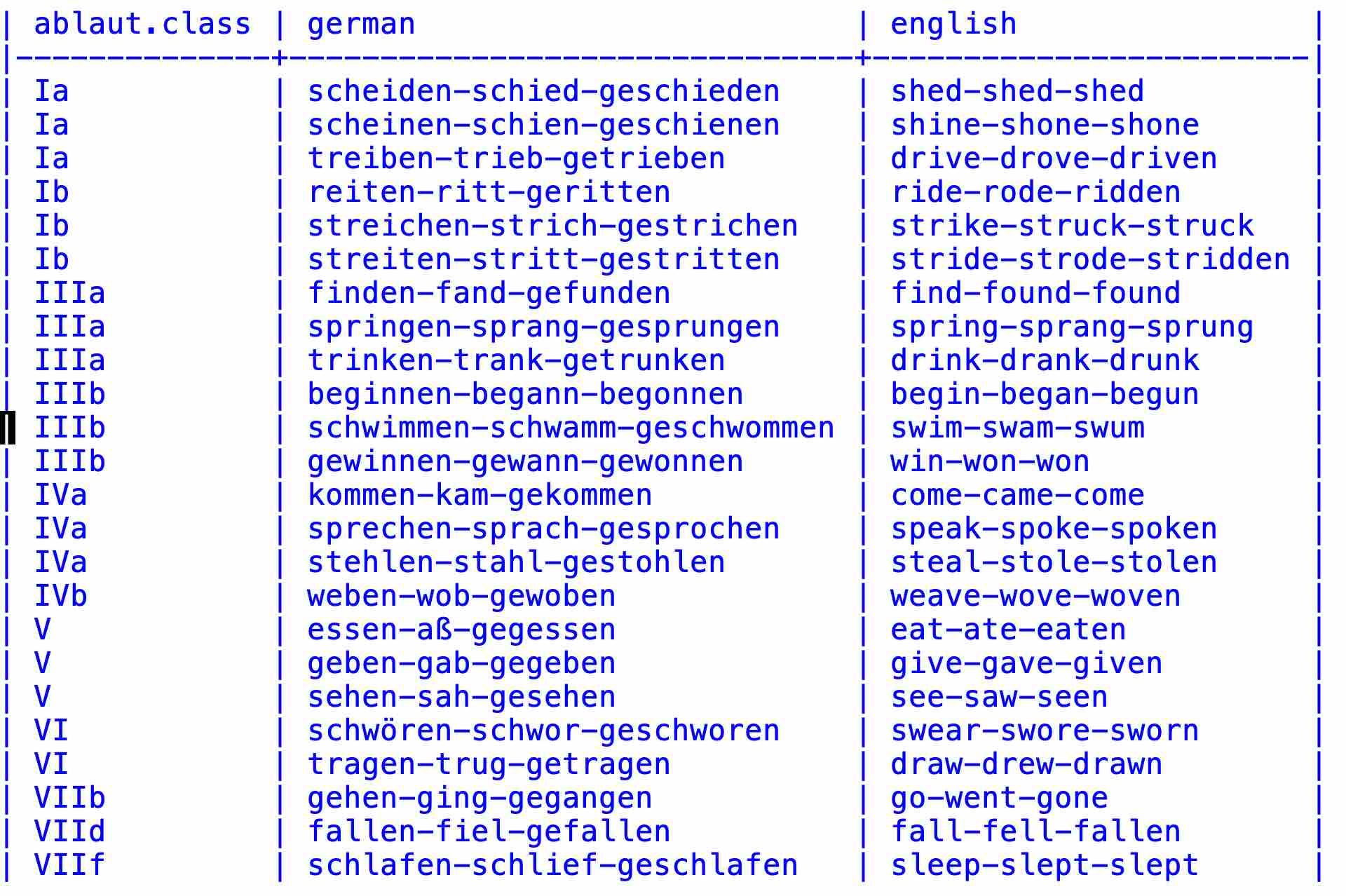Tinder Method for Learning German
Schwippe rechts auf Zunder.
30.12.2023
If you were hoping this new method (*) is about getting matched with an attractive native speaker on a dating app, I'm afraid it's more about words than romance.
To start with a name-giving example: when you first encounter the word Zunder in German, linking it to tinder might not be immediate. But with a bit of practice and guidance, such connections can become second nature.
tl;dr
- Utilize the online dictionary of English-German cognates at langtools.io/tinder to train yourself to reduce a German word to its English cognate by 7 rules of shifting consonants (see rules below, e.g. Zunder → tinder).
- Refer to the comprehensive list of German irregular verbs to recognize their past forms and correlate them with English verbs.
Intro
Certain word pairs, like free and frei or sword and Schwert, are straightforward enough that they almost explain themselves. However, others aren’t so obvious. Take, for instance:
- twitter ↔ zwitschern
- tight ↔ dicht
- hip ↔ Hüfte
Imagine if, by learning just a handful of rules and practicing a bit, you could bypass memorizing hundreds, maybe thousands, of words.
Not as fun as swiping through profiles, but it still can offer some help (Hilfe).
Here’s the game plan:
- Explore why English and German have so much in common.
- Look at important rules showing how these languages are connected.
- Share some great (and free) tools for finding these connections.
- Discuss some tricky parts you might come across.
Exploring Common Roots: The Shared Heritage of English and German
(Optional, and perhaps better for a second read)
From Proto-Indo-European to Proto-Germanic
Our journey starts with the Proto-Indo-European (PIE) language (see related article), evolving into Proto-Germanic, during which the first consonant shift (erste Lautverschiebung — 1LV) occurred.
While fascinating, it’s less relevant here since both English and German are descendants of Proto-Germanic, having already experienced this shift.
From Proto-Germanic to Modern English/German
The second consonant shift (zweite Lautverschiebung — 2LV) was crucial in differentiating High German dialects from Low German dialects.
- High and Low refer to geographic elevation (e.g. Netherlands = Niederlande = Lowlands; Niedersachsen = Lower Saxony).
- English aligns more with Low German consonants.
Both English and German retained the Proto-Germanic system of irregular (strong) verbs. Linguists have identified 7–8 classes, each with its own conjugation patterns. So, while “irregular,” they are actually predictable within groups.
Examples:
- English come–came–come ↔ German kommen–kam–gekommen
- English eat–ate–eaten ↔ German essen–ass–gegessen
English irregular verbs became more “corrupted” over time.
Thus:
- Easy to find German verbs irregular where English isn’t (backen–gebacken vs. bake–baked).
- Harder to find the reverse.
Other interesting aspects (not covered here):
- Extension of verb conjugation into other parts of speech (Einkünfte = income).
- The world of vowel shifts.
Rules / Hints
Enough theory, let’s get down to practice. The main tools:
- Consonant shifts (2LV)
- Verb conjugation patterns
Consonant Shift (English → German)
- p → ff/f: ship → Schiff
- p → pf: pepper → Pfeffer; plough → Pflug
- t → ss/s/ts/tz: eat → essen; set → setzen
- t → z (at beginning): tinder → Zunder
- k/gh → ch: make → machen; night → Nacht
- d/th → t: day → Tag; father → Vater; fold → falten; hold → halten
- th/t → d: think → denken; thirst → Durst; south → Süden
Consonant Shift (German → English)
- ff/f → p: Schiff → ship
- pf → p: Pfeffer → pepper; Pflug → plough
- ss/s/ts/tz → t: essen → eat; setzen → set
- z → t (at beginning): Zunder → tinder
- ch → k/gh: machen → make; Nacht → night
- t → d/th: Tag → day; Vater → father; falten → fold; halten → hold
- d → th/t: denken → think; Durst → thirst; Süden → south
Verbs
Irregular verbs follow recognizable conjugation classes.
We’ve already seen examples above. A full list (~200 verbs) can be studied for deeper understanding.
Tools
I prepared an online dictionary of English-German cognates: langtools.io/tinder. In its alpha version, you can look up ca. 4600 German/English words (e.g. look up tinder).
If you want to go deeper on German irregular verbs, go through this list of ca. 200 irregular verbs assigned into classes: 200+ irregular verb list
Here's a short list I mentioned before: short list.

Houston, we have a problem
It’s not an exact science. Watch out for false friends and anomalies:
- Why father → Vater but brother → Bruder (not Broter)?
- Why lip → Lippe (not Lipfe/Lüpfe/Liffe)?
More on this in: Problems with the Tinder Method of Learning German.
To comment or subscribe: substack
p.s.
- () Maybe not a full “method” to bring you from zero to native, but rather a submethod* for deeper understanding and shortcuts.
- Not entirely new — most facts were discovered in the 19th century. German linguistics professors and language teachers know them.
- These ideas appear in curricula, but are not mainstream in German learning.
- Convenient tools are lacking — this project aims to fill the gap.